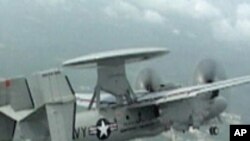For decades, India mostly depended on, first, the Soviet Union and then Russia for its military supplies. But as the Cold War ended and India's relations with the United States began improving during Bill Clinton's presidency, New Delhi gradually increased its military cooperation with Washington. Both New Delhi and Washington have said their relationship is not aimed against India's arch-rival Pakistan. Today, besides holding joint military exercises with the U.S. military, India has also been buying U.S. armaments worth billions of dollars.
<!-- IMAGE -->The latest India-U.S. defense deal is the sale of this Airborne Early Warning Air Craft, Hawkeye E-2D, developed by American arms manufacturer, Northrop Grumman.
Woolf Gross, the corporate director at the company, says the reconnaissance plane has yet to be introduced in the U.S. Navy. Its sale to India, he says, is a symbol of how close India/U.S. military relations are.
"So they [the Indians] could have advanced Hawkeyes in India about the same time that the U.S. Navy becomes fully operational with the same aircraft," he explained.
During Secretary of State Hillary Clinton's visit to India in July, the two countries agreed on the terms of such high technology sales to India.
India's Ambassador to Washington, Meera Shankar is optimistic about future cooperation.
"Our militaries once unfamiliar with each other now hold regular dialog and joint exercises in the air and on land and sea. We coordinate anti-piracy efforts and have worked together on humanitarian missions. Our defense trade was negligible a decade ago. We placed orders worth $3.5 billion last year and it could grow even more in the future," Shankar said.
Since joint exercises between the two countries are expected to grow, it is better for India to buy equipment that is compatible with the U.S. military, says Walter Andersen at Johns Hopkins University. He says India imports most of its oil and gas and other merchandise by sea, and India is in favor of holding more joint naval exercises.
"And there is real and present danger from growing threats of piracy both on the eastern and western ends of the sea lanes coming out of the Strait of Hormuz carrying oil and gas. And also on the Horn of Africa as well as the Somalia coast where there have been real problems," Andersen said.
In the wake of last year's Mumbai terror attacks, Andersen says India is also keen to get help from the U.S. on how to combat terrorism. India blamed the attacks on a Pakistan based militant group known as Lashkar-e-Taiba.
The group is still intact and determined to repeat the Mumbai terror attacks, says Michael Leiter who heads the Counter-terrorism Center in Washington."I think it is worth noting that in Pakistan, Lashkar-e- Taiba, an al-Qaida ally, continues to pose a threat to a variety of interests in South Asia. The group continues to plan attacks on India that could have major geo-political consequences for the U.S. fight against terrorism," Leiter said.
The Mumbai terror attacks were a "wake up" call for India, says Woolf Gross at Northrop Grumman. He says as India shores up security on its coasts, it will also be a large market for U.S. anti-terrorism equipment.
"Speed boats to patrol the coasts in very short range and larger ships further out on the sea constituting a better and broader-based patrol capability as well as operation centers that are geared to share information and provide information back and forth," Gross said.
Military analysts say the ongoing military cooperation between India and the United States is bound to grow as India plans to spend billions of dollars for modernizing it defense capabilities. India, they say, is preparing for short term threats from Pakistan and long-term deterrence against China.







